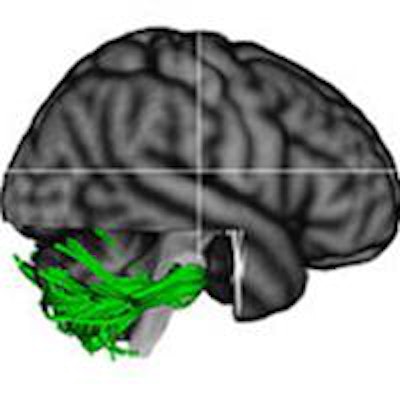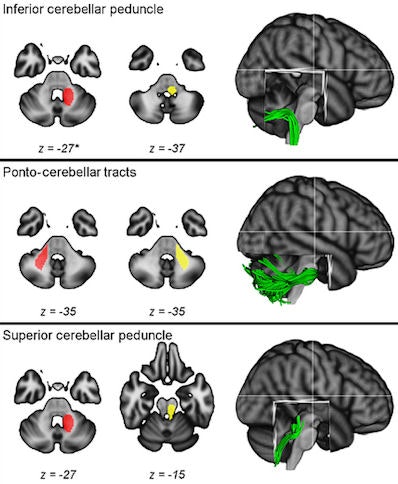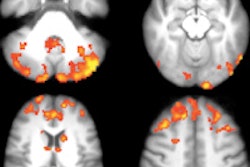
Using diffusion-tensor MRI (DTI-MRI), Italian researchers detected brain changes related to improved balance and movement in multiple sclerosis (MS) patients who regularly trained on a Nintendo Wii balance board for 12 weeks. Results were published online in Radiology.
The group from Sapienza University of Rome found that use of the Wii balance board system for 30 minutes five times a week reduced the risk of accidental falls and increased the walking speed of the 27 MS patients. The improvement was tracked via DTI-MR images of the subjects' left and right superior cerebellar peduncles, areas of the brain that help prompt and control motor coordination throughout the body.
One key finding of the study is that MS patients had to use the balance board regularly to maintain their progress. Individuals who stopped training lost any advances they made, similar to how an athlete regresses when he or she stops training (Radiology, August 26, 2014).
Balancing act
Multiple sclerosis is a disease of the central nervous system in which the body's immune system attacks the protective myelin sheath wrapped around nerve fibers. Approximately two-thirds of MS patients have balance problems, and their risk of injury from falls is approximately twice that of the general population, according to lead author Dr. Luca Prosperini, PhD, from the department of neurology and psychiatry.
"Moreover, there is no pharmacological intervention aimed at improving balance, and some drugs currently used to manage the symptoms of MS, such as antidepressants and antispastics, may even worsen balance," Prosperini wrote in an email to AuntMinnie.com. "Therefore, understanding the causes of balance impairment and providing rehabilitative strategies to improve this function is an emerging area in MS."
Prosperini and colleagues have published several studies in recent years related to balance issues in MS patients and possible sources of the condition. Their most recent study concluded that a "disconnection" exists between the spinal cord, cerebellum, and cerebral cortex in MS patients, which can result in atrophy of sensory motor cerebellar regions and contribute to imbalance (Radiology, July 2013, Vol. 281:1, pp. 181-189).
Physical rehabilitation is often used to help MS patients combat this issue, and the battery-operated Wii balance board is seen as one of the more promising new tools, Prosperini said. Users stand on the board and shift their weight as they follow actions on a TV screen during games such as slalom skiing.
Benefits shown on DTI-MRI
In the current study, the researchers used a 3-tesla MRI scanner (Verio, Siemens Healthcare) and 12-channel head coil to image the brains of 27 MS patients. DTI-MRI was performed before balance board training to acquire baseline images, after 12 weeks of balance board use, and at the end of the 24-week study period.
DTI-MRI allows a detailed analysis of the white-matter tracts that transmit signals through the brain and body, and it can illustrate the degree of demyelination, or lack of protection by the myelin sheath, among faulty brain tracts.
"Conventional MRI is useful for multiple sclerosis diagnosis and follow-up, but it does not provide any useful quantitative information about the degree of damage to the myelin," Prosperini explained. "Only DTI can be used to dissect a specific brain tract ... and is essential to show that after the video game training, there were improvements in DTI indices, which refer to microstructural properties of myelin sheath."
Fractional anisotropy was one of the measures used in the study to evaluate damage to the white matter; the lower the fractional anisotropy value, the greater the damage. Subjects were also tested clinically to assess their balance and equilibrium using a measurement technique known as posturography.
Follow-up imaging
At the 12-week mark, DTI-MRI scans showed significant improvement in nerve tracts, as measured by improved fractional anisotropy in both superior cerebellar peduncles, "suggesting an enhancement of myelination-related processes driven by training-induced white-matter plasticity after high-intensity, task-oriented exercises," the authors wrote.
 Starting region of interest (ROI) (left images), ending ROI (center images), and dissected white-matter tracts (right images) are superimposed onto a standard T1-weighted MR template. Changes in the left and right superior cerebellar peduncles correlated with balance improvements. Images courtesy of Radiology.
Starting region of interest (ROI) (left images), ending ROI (center images), and dissected white-matter tracts (right images) are superimposed onto a standard T1-weighted MR template. Changes in the left and right superior cerebellar peduncles correlated with balance improvements. Images courtesy of Radiology.These DTI-MRI changes "could be considered clinically relevant because they were correlated with improved standing balance detected at static posturography, further supporting our main hypothesis that high-intensity, task-oriented exercises can induce microstructural changes in the cerebellar connections of patients with MS," they wrote.
Some MS patients continued to use the Wii balance board after the study; however, those who stopped had no long-lasting improvement in balance skills. In fact, their balance skills regressed to the level prior to balance board use.
Prosperini speculated that any advances may have been reversed in regions that control the process of myelination.
"Probably certain skills that are related to structural changes in the brain and are acquired or reacquired after an injury need to be kept trained constantly," he said. "In this regard, long-term benefits can occur only with continuous training, but this is probably not an MS-specific phenomenon, as even athletes lose some skills after stopping their training."
Prosperini and colleagues plan to continue their research in the field of balance disorders, and they currently are collaborating with computer engineers to validate the balance board as a portable, low-cost way to assess and improve patients' balance.
They are also investigating the relationship between balance disorders and cognitive deficits in people with multiple sclerosis.
"However, the most fascinating area for future research may involve the possibility of a 'far transfer effect' after balance rehabilitation," Prosperini said. "That is, the possibility that improvement in balance may be coupled with improvement in cognitive abilities."



.fFmgij6Hin.png?auto=compress%2Cformat&fit=crop&h=100&q=70&w=100)




.fFmgij6Hin.png?auto=compress%2Cformat&fit=crop&h=167&q=70&w=250)











